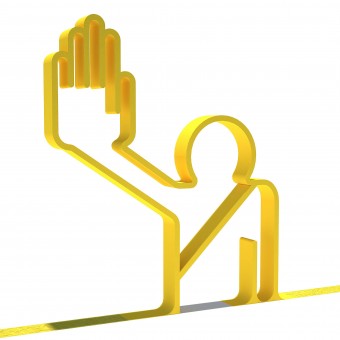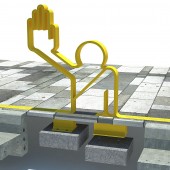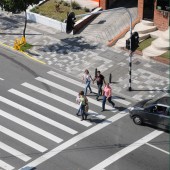
| THE AWARD |
| CATEGORIES |
| REGISTRATION |
| SUBMIT YOUR WORK |
| ENTRY INSTRUCTIONS |
| TERMS & CONDITIONS |
| PUBLICATIONS |
| DATES & FEES |
| METHODOLOGY |
| CONTACT |
| WINNERS |
| PRESS ROOM |
| GET INVOLVED |
| DESIGN PRIZE |
| DESIGN STORE |
| THE AWARD | JURY | CATEGORIES | REGISTRATION | PRESS | WINNERS | PUBLICATIONS | ENTRY INSTRUCTIONS |
Don Luis Traffic Signal by CasBeVilla Team |
Home > Winners > Design #33331 >Interview |
 |
|
FS: What is the main principle, idea and inspiration behind your design?
DV: The main principle of Don Luis is its symbolic code for people (an instructive for being a model citizen). It is different to others due to their development based from a sociocultural analysis and not from aesthetic guidelines merely. In other words seeks to transfer the good behavior and the idea of security implemented by the Medellin Metro to the streets. Let´s remember that the decisions we adopt by nature are taken in a rational (10%) and subconscious manner (90%). For example: “I respect Don Luis traffic signal because of it´s clear to understand where I should cross the street due to its form and color”: rational decision; “I respect Don Luis in order to be a model citizen, on the contrary, I might be rejected by society”: subconscious decision.
FS: What has been your main focus in designing this work? Especially what did you want to achieve?
DV: Initially we wanted to change the people mentality as pedestrians and also reduce the raised accidental figures. We noticed since smart cameras began to function in the city the human behavior also changed, and also we took into account that definitely people change if you work according to their insights or cultural codes. For that reason we adopted the “Metro Culture” (developed by the Medellín Metro) to the streets.
FS: What are your future plans for this award winning design?
DV: Our plans are to adopt Don Luis to each place in the world in where pedestrian vulnerability is a real problem for society development; a society with good habits is a great asset to humanity.
FS: How long did it take you to design this particular concept?
DV: The design was developed in 5 months comprising the steps of definition of the topic, research, problem statement, hypothesis, definition of objectives, drawing sketches, 3D modeling, prototype development, preparation of mechanical simulations, validation in the public space, and final details.
FS: Why did you design this particular concept? Was this design commissioned or did you decide to pursuit an inspiration?
DV: As we mentioned, the strongest reason why we continue developing this design (that started as an academic project), was for wanting to respond the question: Why people do not implement when crossing the streets the excellent behavior (The Metro Culture) they have when they use the Medellin Metro?
FS: Is your design being produced or used by another company, or do you plan to sell or lease the production rights or do you intent to produce your work yourself?
DV: The design was produced but not in a serialized manner, the aim goal is to spread this idea to countries with high accidental figures of pedestrians, so, if any third party is interested in the design we are open to negotiate, further when we know that governments are interested in reducing the mortality figures for the welfare of society and to reduce public spending.
FS: What made you design this particular type of work?
DV: Our ethical point of view of design as a tool for social development, as Ezio Manzini says, designers must not continue generating so much garbage (products without meaning), and we noticed it should be focusing on basic needs for people and not focusing on product aesthetics merely. Hence, we defined at the beginning that Don Luis would be our contribution to the world.
FS: Where there any other designs and/or designers that helped the influence the design of your work?
DV: Yes, Juan Pablo Gaviria, industrial designer that contributed with technical aspects of the character to take into account in the public space, and David Ortega, a publicist that gave us opinions related to the culture analysis.
FS: Who is the target customer for his design?
DV: Pedestrians, cyclists and motorcyclists which are most vulnerable actors for traffic accidents.
FS: What sets this design apart from other similar or resembling concepts?
DV: Its symbolic code for people (an instructive for being a model citizen), we mean the recontextualization of a respected world like The Medellín metro, to the streets. It is different to others due to their development from a sociocultural analysis and not from aesthetic guidelines merely.
FS: How did you come up with the name for this design? What does it mean?
DV: Its name comes from its abundance in the city of Medellin, which facilitates its remembering; in addition, the human quality of their inhabitants and their ease to socialize, facilitate it´s perception, not as a "traffi c signal" but more as a friend.
FS: Which design tools did you use when you were working on this project?
DV: After sketching, we used Rhinoceros to make the 3D solid and rendered it with Vray. The postproduction of the renders was done with Adobe Photoshop. The mechanical tests were done with Solidworks. To make the prototype we implemented digital fabrication with a CNC router and Enroute software to generate the (.GC) code.
FS: What is the most unique aspect of your design?
DV: The cultural code that characterizes it but if you mean aesthetics, the applied principles of signage like simplicity, readability and not generating visual contamination.
FS: Thank you for providing us with this opportunity to interview you.
A' Design Award and Competitions grants rights to press members and bloggers to use parts of this interview. This interview is provided as it is; DesignPRWire and A' Design Award and Competitions cannot be held responsible for the answers given by participating designers.
| SOCIAL |
| + Add to Likes / Favorites | Send to My Email | Comment | View Press-Release | Translations |




